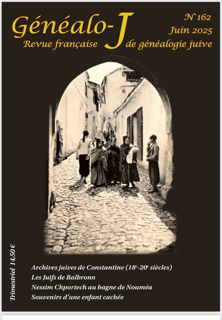
Joëlle Allouche Benayoun
Jewish archives of Constantine (1795-1929). Trousseaux, rabbis, synagogues, Dars, births ...
Joëlle Allouche-Benayoun reports on the research she is carrying out with Jean-Paul Durand and Michel Zaffran, on parts of the Jewish archives of Constantine, housed at the Central Archives for the History of the Jewish People (CAHJP) in Jerusalem. Partially written in maalaq (North African Sephardic cursive), the 27 engagement registers are packed with previously unpublished information on the civil status of the city’s Jewish population from 1795 to 1846 (the date the city was taken by the French) and beyond (until 1929), details of the brides’ trousseaux, places of prayer and residence, and even, in part, births.
Claude-Alexis Gras
The Jews of Balbronn from the second half of the 17th century to the 1730s
In the first decades after the end of the Thirty Years’ War, a very small number of Jewish families lived in Balbronn, each with a special link to the Bouxwiller community. But once the major upheaval of the Dutch War had passed, the Jewish population grew steadily throughout the late 17th and 18th centuries. The work of André-Marc Haarscher and Pascal Faustini, and above all the very rich documentation preserved in the Bas-Rhin departmental archives, have enabled us to reconstruct the genealogy of the families who founded (or perhaps refounded) the Balbronn community. The results of this research also shed new light on the origins of the Arons of Phalsbourg, as well as on the genealogy of certain families from Marmoutier, Scharrachbergheim, Neuwiller and Westhouse.
Rémi Chicheportiche
Nessim Chportech in the bagne of Nouméa
The case of Nessim Chportech, an Algerian Jew transported to the Nouméa penal colony in 1896, illustrates how DNA sequencing is revolutionizing genealogy and challenging traditional methods based on paper archives. It reveals unexpected descendants, often hidden and hushed up.
Claire Romi
Memories of a hidden child
Claire Romi recounts her childhood in the Paris region during the German Occupation, hidden with her mother and brother by a modest, kind-hearted family, the Corberys, who were recognized as “Righteous Among the Nations” by Yad Vashem (Jerusalem).